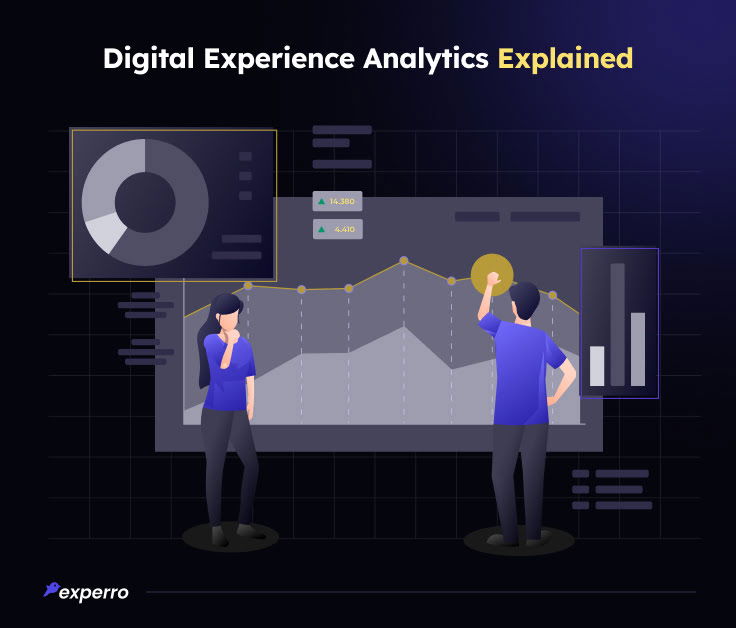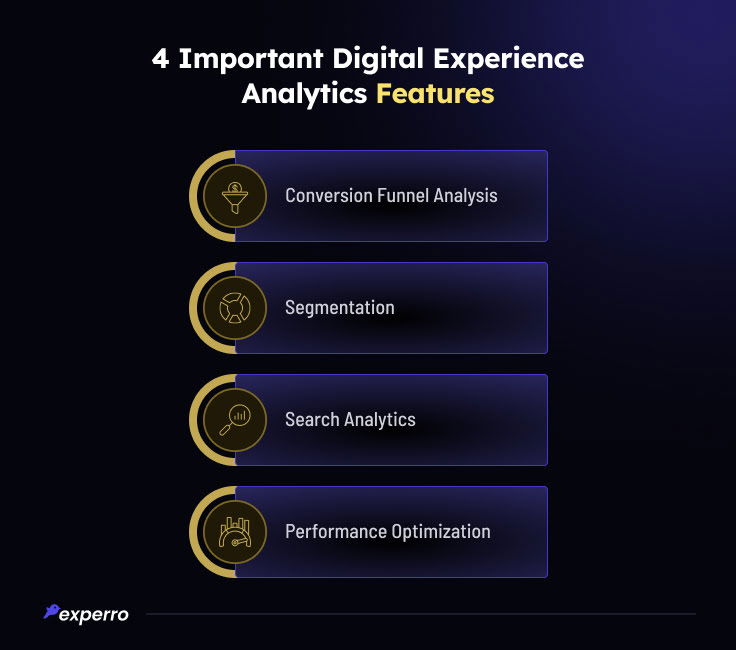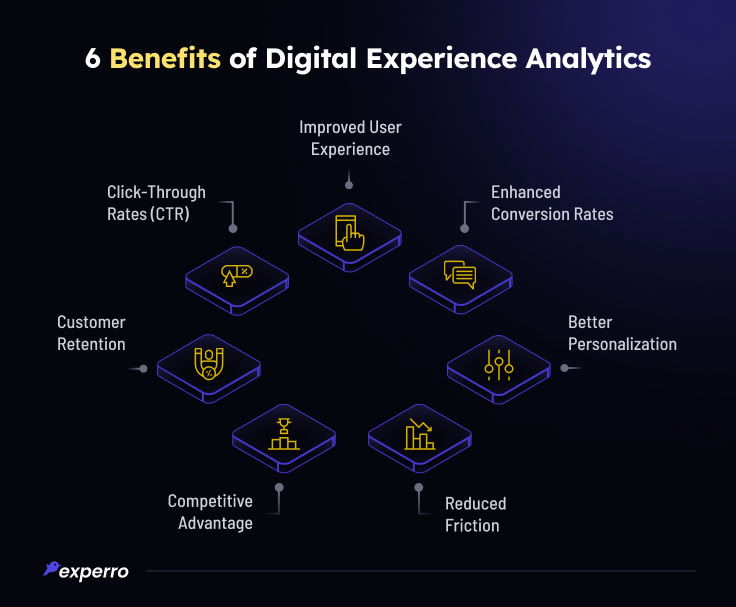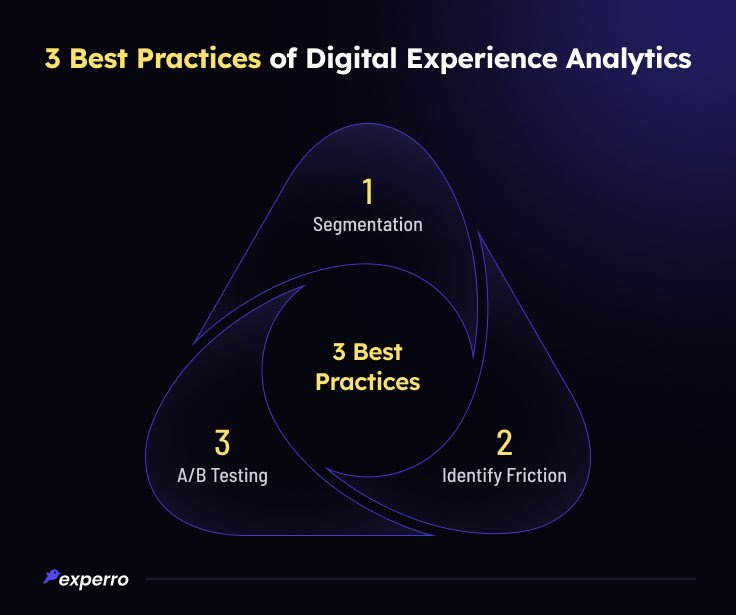Digital Experience Analytics – Examine Every Click of Users!

What’s Inside
- What Is Digital Experience Analytics?
- What Are the Features of Digital Experience Analytics?
- What are the Digital Experience Analytics Benefits?
- What Is the Role of User Journey in Digital Experience Analytics?
- What Are Some Digital Experience Analytics Best Practices?
- What Are Some Digital Experience Analytics Use Cases?
- Unlock Actionable Customer Insights to Elevate Online Presence
- How Can Experro’s Analytics Tool Help to Increase Conversions?
- Start Taking Data Driven Decisions with Digital Experience Analytics
- Conclusion
KEY TAKEAWAYS
- Digital experience analytics, provides valuable insights into user behavior and preferences that help businesses understand the audience better.
- By identifying user preferences, businesses can optimize customer experiences.
- Digital experience analytics allows businesses to implement personalized and effective marketing strategies.
- Experro DXP enables businesses to gain valuable customer insights through its analytics feature.
Making a decision without considering/looking at the data is like trying to hit the target in the dark!
When it comes to making data-driven decisions, knowing how users engage with your website is important.
Every click, scroll, and interaction by users is valuable information which can be utilized to improve your digital strategies.
That is where digital experience analytics come into the picture.
It's like a guiding light to hit the right target at the right time, so you don't miss potential opportunities.
When leveraged effectively, it empowers businesses to provide customers with exactly what they are looking for.
In this blog, we will deep dive into what digital experience analytics is and how it can help marketers make data-driven decisions. So, without further ado, let's first understand its meaning.
What Is Digital Experience Analytics?

Digital experience analytics is the process of measuring customer interaction on various platforms, such as websites, mobile apps, or social media, to gain valuable customer insights.
It includes customer insights such as website traffic, behavioral data, session duration, bounce rates, etc.
The aim of digital experience analytics is to enable organizations to make data-driven decisions and eventually improve user experiences.
What Are the Features of Digital Experience Analytics?

The notable features of digital experience analytics are as follows:
1. Conversion Funnel Analysis
Conversion funnel analysis allows businesses to track a specific path users take toward a goal on a website.
It could be making a purchase, signing up for a newsletter, etc. It involves breaking down the user's journey into different stages to identify when the user made a decision to complete a specific goal.
Through this feature, businesses can also identify the pitfalls in the customer journey orchestration and fill those gaps with potential solutions.
For instance, a conversion funnel of an online store begins with a user landing on a specific page, selecting the product, adding it to the cart, and completing the purchase.
2. Segmentation
Segmentation allows organizations to divide their user data into different groups.
This enables a deeper understanding of customer needs, behavior, and activities of a certain group of people.
Segmentation can be based on various user characteristics, including demographics (age, gender, location), device type (desktop, mobile, tablet), traffic source (organic search, social media, referrals), and more.
3. Search Analytics
The search analytics feature helps to understand how the user interacts with the search functionality of a website.
Basically, it gives an idea of which keywords users are putting in while searching for certain products.
Identifying how and what users search for helps understand their intent behind the search and improve search results.
Pinpointing areas where users struggle to find the relevant results for search helps to bring viable solutions and provide what users are exactly looking for.
For instance, through the analysis of user's search query marketers of an eCommerce store find out that a significant number of users are searching for 'red sole shoes,' but not finding any relevant results.
By pinpointing this issue, they can add a new category or refine the search algorithm.
What other insights does the search analytics feature provide?
- Total number of searches
- Average search per day
- Total search revenue
- Search conversion rates
These key search analytics insights empower businesses to optimize their search functionality and maximize revenue generation through data-driven decisions.
4. Performance Optimization
Digital experience analytics not only helps with user insights but also provides performance optimization information.
It analyzes metrics like page load times responsiveness and error rates that are important to ensure a seamless experience.
What are the Digital Experience Analytics Benefits?

The following are prominent benefits of digital experience analytics:
1. Improved User Experience
Did you know? 88% of the customers say they won't return to a website after having a bad user experience.
Digital performance and analytics often focus on fetching valuable insights from user interactions and enable businesses to make data-driven decisions.
It tracks user journey and navigation path to identify potential opportunities to convert users.
Additionally, it enhances eCommerce customer experiences by addressing their challenges while navigating the website.
2. Enhanced Conversion Rates
Digital experience analytics tools play a pivotal role in optimizing conversion rates by providing rich insights into user behavior.
For instance, by analyzing user behavior on an eCommerce website, marketers can identify specific interactions from where users leave the website.
This data-driven approach enables targeted improvements to these stages.
3. Better Personalization
A total of 70% of consumers say, how well a company understands their individual needs impacts their loyalty.
With a deeper understanding of user behavior and preferences, DXA enables personalized content creation.
By analyzing historical data and user activity, businesses can create personalized experiences for customers.
To create personalized experiences, businesses can implement following strategies:
- Tailored product/content recommendations based on user's browser history
- Personalized landing page to showcase relevant products
- Cross-selling and upselling by recommending additional products of customer's interest
Experro's eCommerce merchandising feature helps with product discovery by strategically showcasing products and offering personalized recommendations.
4. Reduced Friction
Friction points are areas where users may encounter frustration, confusion, or delays in the journey.
By identifying these areas through digital data, businesses can leverage the opportunity to come up with a solution.
For example, if analytics highlight that users are facing frequent issues in the onboarding process, the company can implement a guided process as a solution.
5. Competitive Advantage
Having an understanding of customer experiences through user experience insights provides a competitive advantage to businesses.
This is why businesses should always create the best digital content strategy and stay ahead of their competitors.
6. Customer Retention
Improving customer retention by 5% can lead to a remarkable 75% increase in profits.
Digital customer experience analytics plays a pivotal role in enhancing customer journeys and retaining them.
It allows users to analyze customer interaction and derive specific data from that.
By understanding how users navigate through digital platforms and devices, businesses can identify patterns, preferences, and areas that lead to improvement.
Through analysis, they can streamline the customer journey with their business goals.
This is how they can create a smoother and memorable digital customer experience, which helps to increase brand awareness and retain customers.
What Is the Role of User Journey in Digital Experience Analytics?
To create memorable digital experiences, businesses must embark on a journey of customer behavior.
Knowing how users navigate the website, what encourages them to click on particular products, and where they might encounter friction is important to create better experiences that relate to customers.
The following points highlight the role of the user journey in digital experience analytics.
1. Fostering Empathy with Relatable Content
Your content must resonate with your target audience.
Content must connect with your audience on a personal level, evoking certain emotions that trigger them to make a purchase.
It can be achieved through compelling narratives, personalized landing pages, or user-centric messaging.
For instance, by identifying what type of content users are searching for, content marketers can form FAQs that resonate with the user’s query.
2. Alignment with Business Goals
Digital experiences must also align with business goals.
These business goals can include increasing conversion, increasing social media engagement, or making users download the app.
Additionally, it should also align with the digital experience design.
By deriving valuable user insights, businesses can align their strategy with customers. A well-crafted content or a well-designed user journey strategically guides users to complete certain actions.
What Are Some Digital Experience Analytics Best Practices?

Following points highlights the best practices of digital experience analytics:
1. Segmentation
Segmentation involves dividing your users into groups on the basis of their shared characteristics. Marketers can smartly segment their users after deriving insights from digital experience analytics.
The common segmentation criteria include following aspects:
- Demographics - age, gender, location
- Behavior - frequency of visits, pages visited, time spent
- Psychographics - interests, preferences
- Preferred channel for communication
- Active or inactive users
- High or low value customers
These segments can be used for creating tailored marketing campaigns and enhancing customer satisfaction.
2. Identify Friction
The best way to utilize the user's insight is to identify friction in the journey. This involves pinpointing obstacles or pinpoints that lead users to abandon a particular process within the platform.
Marketers can bring improvement in the areas where users encounter friction.
Resolving friction points can lead to a smoother user journey, fostering a positive perception of your brand.
3. A/B Testing
After deriving ideas from digital experience analytics, marketers often come up with new ideas and strategies to resonate with the target audience.
However, what is most important is to identify the best version of your marketing asset through A/B testing.
A/B testing allows experiment, that is validated by your users. This leads to improved user engagement and satisfaction.
What Are Some Digital Experience Analytics Use Cases?
The use cases of digital experience analytics are as follows:
- Understanding user behavior, patterns, and preferences
- Track website performance and identify errors that affect user's satisfaction
- Check effectiveness of various digital channels in the user journey
- Determine which keywords lead to higher user engagement and conversions on your website or app
- Understand the touchpoints that influence a customer's decision to purchase a particular product
- Gain insights into your customer demographics and geographic locations
- Identify which products are frequently abandoned in shopping carts and understand the reasons behind abandonment
How Can Experro’s Analytics Tool Help to Increase Conversions?
The analytics feature of Experro offers rich insights into user interaction across various digital platforms and touch points.
By delving into deep insights such as clicks, navigation parts, and time spent on specific page sources of interactions, businesses can gain profound insights of user behavior.
Comprehensive user experience analytics allow organizations to identify high-performing elements and areas that might need optimization.
Not only that but from initial interaction to final conversion, businesses can track the whole user journey and pinpoint stages where users drop off or encounter any friction.
With these rich insights, businesses can strategically optimize their conversion funnel and minimize the barrier.
By understanding individual preferences and behaviors, businesses can employ personalized strategies tailored to their target base.
Let’s take a look at how Experro helps with digital experience analytics from the points mentioned below:
- First-party analytics
We at Experro do not use third-party tools to load the script and send data. Our data is more comprehensive and accurate.
- What do we track?
Traffic, page views, clicks, bounce rates, top-performing pages and products, user history, etc.
- Timeline of customer interactions
Every single interaction of customers is recorded with the complete timeline, such as page view time.
- Segmentation
Segment users by device type or platform (e.g., mobile, desktop, iOS, Android) to ensure consistent experiences across different channels.
Conclusion
In conclusion, digital experience analytics isn't just about data analytics but it’s a transformative approach towards reaching new heights.
Every customer interaction can be strategically directed toward fulfilling specific goals such as conversions, sign-ups, etc.
Experro is a digital experience platform, and its analytics feature provides the most accurate and detailed insights into user behavior for organizations.
Book a demo to know how we can help you elevate online success!
FAQs


Priya Zala
20 June 2024Through her writing, she has a lovely way of capturing users' pain points and delivering solution-oriented content. Her writing is sure to captivate readers and leave them with a lasting impression. When not crafting content, Priya enjoys getting lost in a good work of fiction, which soothes her soul.